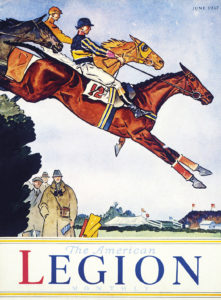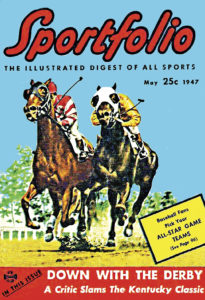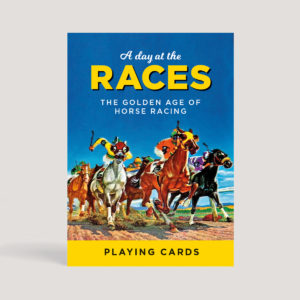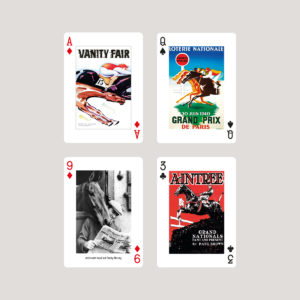A FLUTTER AT THE RACES
Racing is the Sport of Kings and the sport of the people. It has been around since antiquity. By 648 BC the Greek Olympics featured mounted horse races. Chariot races, often violent spectacles fatal to riders and horses, were the rage in Ancient Rome, topping the bill with Gladiators v Lions. As now, the best seats went to the smarter or richer types. The difference today is social mobility. If you have the money you can get into any Enclosure (where horses parade before a race). Royal Ascot is different; new applications for a pass to the Royal Enclosure must be supported by someone who’s been attending for at least four years. And there is a dress code. Stewards will refuse admission if you’re inappropriately dressed – and will usher you away from Her Majesty if you’re tipsy. Many punters are.
DANGEROUS GAME
 Racing is still dangerous to horse and jockey. The great jump jockey Tony McCoy remarked: ‘You don’t have to be Einstein to see that horse racing is dangerous. Those two ambulances driving behind you aren’t there for the scenery.’ Steeplechasing (big fences) and hurdling (smaller) claim more broken bones than the flat, but flat racing (over turf in the UK, often dirt in the US) is hardly ping pong. A 1200 lb horse travelling at 50 mph is a potentially lethal projectile. The Grand National at Aintree has the biggest jumps – Becher’s has a 6 ft 9in drop (like ‘jumping off the edge of the world’). The classical form of an ancient arena, oval and level, is still the norm for flat courses but there are variations: Windsor is a figure of 8, and Epsom has a steep gradient from Tattenham Corner to the finish. The big money in racing is on the flat. It attracts the biggest prizes, and stables like Maktoum’s Godolphin and Magnier’s Ballydoyle are huge industries. Flat horses are Thoroughbreds and trace back to three stallions imported into England from the Middle East 300 years ago; most are descended form the greatest horse ever, the undefeated Eclipse (‘Eclipse first and the rest nowhere’).
Racing is still dangerous to horse and jockey. The great jump jockey Tony McCoy remarked: ‘You don’t have to be Einstein to see that horse racing is dangerous. Those two ambulances driving behind you aren’t there for the scenery.’ Steeplechasing (big fences) and hurdling (smaller) claim more broken bones than the flat, but flat racing (over turf in the UK, often dirt in the US) is hardly ping pong. A 1200 lb horse travelling at 50 mph is a potentially lethal projectile. The Grand National at Aintree has the biggest jumps – Becher’s has a 6 ft 9in drop (like ‘jumping off the edge of the world’). The classical form of an ancient arena, oval and level, is still the norm for flat courses but there are variations: Windsor is a figure of 8, and Epsom has a steep gradient from Tattenham Corner to the finish. The big money in racing is on the flat. It attracts the biggest prizes, and stables like Maktoum’s Godolphin and Magnier’s Ballydoyle are huge industries. Flat horses are Thoroughbreds and trace back to three stallions imported into England from the Middle East 300 years ago; most are descended form the greatest horse ever, the undefeated Eclipse (‘Eclipse first and the rest nowhere’).
ATMOSPHERE
 ‘Always buy a First Class RETURN train ticket to the races,’ wrote the Spectator journalist Jeffrey Barnard, because you could then return home in comfort after losing your money. Good advice. Betting in Britain can be done, since 1960, off course (at 9000 betting shops) but that is to miss the whole point of racing: the glamour, the colour of being there. Much remains of the vibrancy of old: the jockeys’ silks, the bookies’ banter, the grandstand cheer… but much has been lost. The white-gloved tic-tac men who signalled the odds on the course are gone. So are the lurid betting cards bookies issued as receipts. Mobile phones, the internet have seen to that. Bookies are a strangely British phenomenon; in Europe and the US the Tote reigns, the official way to wager. For me it is soulless. Bookies are now heavily regulated and won’t ‘do a runner’ if too many favourites win; the days of the old Brighton Race Gangs (aka ‘razor gangs’), when they ruled the best bookies’ patches, are over. But a little ‘bovver’ was part of the fun of racing; the spivs, conmen and tipsters were part of the scene, along with the funfair at Epsom and the palm-reading ‘gypsies’. The most famous tipster was Prince Monolulu (‘I gotta horse!’), a fixture – until his death in 1965 – at English courses for 50 years. He was no more a prince than I am.
‘Always buy a First Class RETURN train ticket to the races,’ wrote the Spectator journalist Jeffrey Barnard, because you could then return home in comfort after losing your money. Good advice. Betting in Britain can be done, since 1960, off course (at 9000 betting shops) but that is to miss the whole point of racing: the glamour, the colour of being there. Much remains of the vibrancy of old: the jockeys’ silks, the bookies’ banter, the grandstand cheer… but much has been lost. The white-gloved tic-tac men who signalled the odds on the course are gone. So are the lurid betting cards bookies issued as receipts. Mobile phones, the internet have seen to that. Bookies are a strangely British phenomenon; in Europe and the US the Tote reigns, the official way to wager. For me it is soulless. Bookies are now heavily regulated and won’t ‘do a runner’ if too many favourites win; the days of the old Brighton Race Gangs (aka ‘razor gangs’), when they ruled the best bookies’ patches, are over. But a little ‘bovver’ was part of the fun of racing; the spivs, conmen and tipsters were part of the scene, along with the funfair at Epsom and the palm-reading ‘gypsies’. The most famous tipster was Prince Monolulu (‘I gotta horse!’), a fixture – until his death in 1965 – at English courses for 50 years. He was no more a prince than I am.
BETTING
Betting is the lifeblood of the sport, the levies on the betting industry support it, the racing fraternity often depend on it. Most stable lads need the perk of a win or two (gained with inside knowledge perhaps) to augment their meagre pay. Owners try and claw back their expenses (hardly any show a profit from prize money) with a bet, and many of the 600 trainers in the UK need a punt to survive. The handicap race is preferred. The official handicapper weights the horse (literally a weight in a bag) according to form. But a horse’s form can be misleading, if the horse has underperformed. Doping is rare these days (science can detect it). But betting on a horse to lose (now legal) encourages dodgy jockeys to ‘throw’ a race. I once saw a rider literally jump off his horse at Fontwell before the last fence, with all the subtlety of Frankie Dettori leaping off his horse in the Enclosure. He went up before the Stewards to explain himself. ‘I was stung by a bee’ was his excuse. Must have been a hell of a bee.


